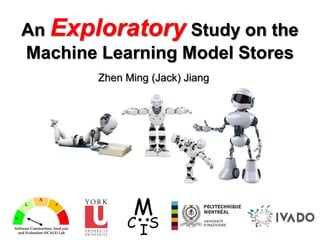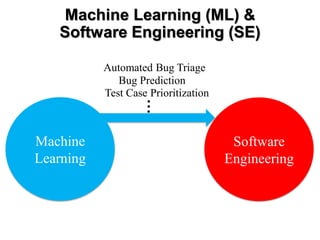An Exploratory Study on Machine Learning Model Stores
- 1. An Exploratory Study on the Machine Learning Model Stores Zhen Ming (Jack) Jiang
- 2. Machine Learning (ML) & Software Engineering (SE) Software Engineering Machine Learning
- 3. Machine Learning (ML) & Software Engineering (SE) Software Engineering Machine Learning .. Bug Prediction Test Case Prioritization Automated Bug Triage .
- 4. Machine Learning (ML) & Software Engineering (SE) Software Engineering Machine Learning .. Bug Prediction Test Case Prioritization Automated Bug Triage . Test ML Applications
- 5. Machine Learning (ML) & Software Engineering (SE) Software Engineering Machine Learning .. Bug Prediction Test Case Prioritization Automated Bug Triage . Test ML Applications Anything else???
- 10. ML Model Stores
- 11. ML Model Stores January 2018 June 2018 November 2018 November 2018 April 2019 (beta)
- 12. ML Model Stores January 2018 June 2018 November 2018 November 2018 April 2019 (beta) What are the unique SE practices/challenges for building ML applications?
- 14. Structure
- 15. What kind of information elements do ML model stores provide? January 2018 June 2018 November 2018 November 2018 April 2019 (beta)
- 16. What kind of information elements do ML model stores provide? January 2018 June 2018 November 2018 April 2019 (beta)
- 17. What kind of information elements do ML model stores provide? January 2018 June 2018 November 2018
- 18. What kind of information elements do ML model stores provide? January 2018 June 2018 November 2018 October 2008 July 2008
- 21. Identifying Information Elements ML Algorithm Owner
- 22. Identifying Information Elements Framework ML Algorithm Owner
- 23. Identifying Information Elements Framework Training set ML Algorithm Owner
- 24. Identifying Information Elements LicenseFramework Training set ML Algorithm Size Usage Statistics User feedback User Manual Owner
- 25. Identifying Information Elements LicenseFramework Training set ML Algorithm Size Usage Statistics User feedback User Manual Owner
- 26. Identifying Information Elements LicenseFramework Training set ML Algorithm Size Usage Statistics User feedback User Manual Owner
- 29. To package an ML application for release - Source code -Trained ML model(s) -Training set info Integrating such a model … - API calls, re-train on new data?
- 30. To package an ML application for release - Source code -Trained ML model(s) -Training set info Integrating such a model … - API calls, re-train on new data?
- 32. Quality representation - Statistics vs. QoS measures (reliability) - Requirements for different ML applications
- 34. [Pricing] Subscription-based - Pricing scheme vs. actual usage context Capacity planning for ML applications
- 36. How unique are the ML models provided by each model store? Very few cross-store ML applications - Vendor lock-in - Need for cross-platform frameworks
- 37. Same ML Models Different Usage Context
- 38. Same ML Models Different Usage Context
- 39. Minor Releases Different Product Pages
- 40. Minor Releases Different Product Pages
- 41. Minor Releases Different Product Pages A new version for an ML application is: - same ML model re-trained on another dataset? or - same dataset with different ML implementations?

































![[Pricing] Subscription-based
- Pricing scheme vs. actual usage context
Capacity planning for ML applications](https://image.slidesharecdn.com/semla2019xiupdf-190525204142/85/An-Exploratory-Study-on-Machine-Learning-Model-Stores-34-320.jpg)







